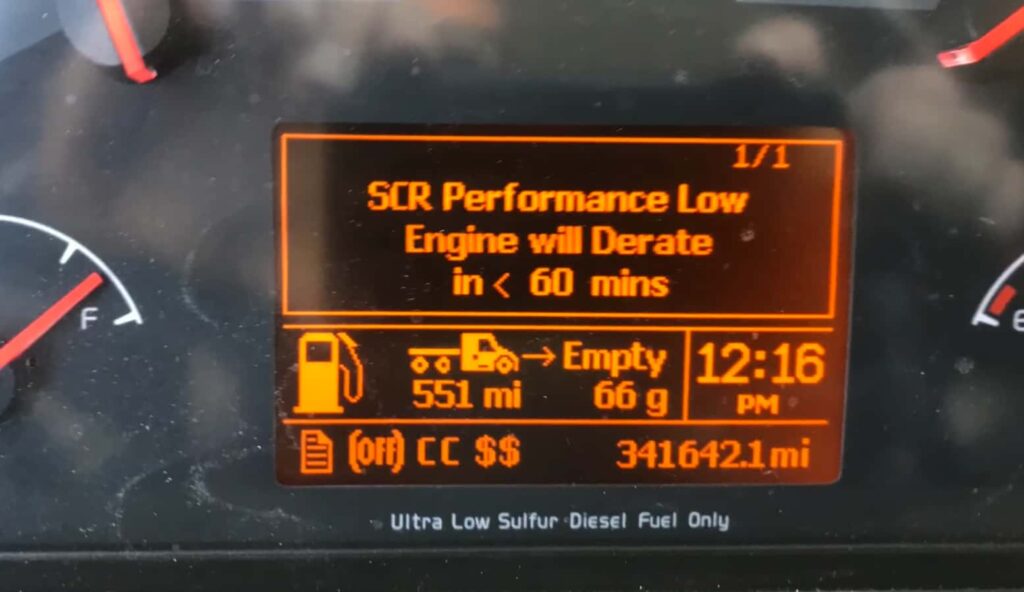A SCR performance low Volvo issue is not an uncommon thing. In fact, there are quite a few owners who complain about this issue and wonder how they may be able to solve it.
When there is a code showing up along with the beeping sound, this means a fault is present in your system. The system is unable to get up to specs including the required heat for performing the system spraying or necessary regen. So, when the external temperature is cold, your truck would require more time to warm up in order to perform a regen and eliminate the SCR fault.
So, why does this happen and what does this mean for you? Most importantly, what can you do about it? Keep reading to learn more.

SCR Performance Low Volvo Vehicle Issues
SCR or Selective Catalytic Reduction refers to the aftertreatment that minimizes the NOx in your engine emissions. This is done by introducing a diesel exhaust fluid, and this creates a chemical reaction in your catalysts, which then forms molecules of water, oxygen and nitrogen. These are all performed while at the same time maintaining an acceptable performance, back pressure and engine efficiency.
What SCR does is that it allows vehicle owners to meet the required emission standards while at the same time ensuring the longevity and durability of the vehicle. The system captures the exhaust and then mixes this with diesel exhaust fluid with urea in their SCR. Thus, there is up to 75 percent reduction in the nitrogen oxide being emitted by the vehicle.
With a combination of the IPS system and the SCR, this also reduces fuel consumption, as well as the carbon dioxide emissions by as much as 30 percent. At the same time, this increases fuel efficiency by about 40 percent.
Causes Of Low SCR Performance
When the SCR system is not working properly, this can result in a 5 PMH derate in Volvo trucks. What this means is that a program in your computer limits the vehicle speed or power of your vehicle. It is intended to protect your vehicle from causing any damage to the engine or DPF. Certain systems or sensors can cause this derate.
Basically, there are a few components making up your emission system, which control your 5 MPH derate. These include your DEF fluid, DEF pump assembly, NOx sensors such as the outlet, ACM, and the DEF doser valve.
When your vehicle has a bad DEF fluid, it can result in DEF quality issues, which then leads to a derate.
As for the DEF pump assembly, when it is faulty, it causes the vehicle to derate immediately. The NOx sensors detect the NOx in your exhaust stream. Then, it communicates with your SCR and DEF system to put in more urea. This then uses ammonia in reducing the system’s emissions levels.
And lastly, the Aftertreatment Control Module or ACM controls your emission system’s operation. Both the ECM and the ACM communicate directly in ensuring an operational system. Moreover, this helps to regulate the DPF system and other relevant sensors.
When you see a fault code, this leads to a 5 MPH derate, which is linked to SCR Inducement that regulates the vehicle to a derate.
Some people wonder if it is possible to override the 5 MPH derate temporarily on their Volvo. There are instances that some allow this to happen by unplugging your speed sensor on your transmission. You can find this at your transmission’s tail shaft or on the right portion of your rear transmission.
By doing so, you can eliminate the speed from showing up on the dashboard upon disconnecting. It also limits the RPM to as much as 1400 RPM, which also prevents full power. This also requires changing gears manually since the transmission is not aware of the speed. However, we do not recommend this method. Yet, it is a useful technique when in an emergency.
Do take note that there are trucks that are unable to go more than 5 MPH even when disconnected. Thus, this technique may not be applicable at all.
Considering these things, you may be wondering how you can fix this 5 PMH derate. First, you should check the cause of this SCR inducement code, which triggers it to appear to begin with. Usually there is a failed component, which triggers the code.
Perhaps, you have insufficient DEF fluid, a failed DEF doser value, and EGR system malfunction that cause the NOx efficiency issue, your ACM failed, the NOx sensor inlet and outlet failed, or there is a DEF pump failure.
If there are problems with your emission system, you should be able to do updates. If these are available, then you should consider making updates. You may also want to check for available updates and be sure to do these. In most cases, an update should fix the issue or bug.
But at the same time, this is not the ultimate fix for this issue. On the other hand, it is always good to keep your emission system to the latest update whenever possible.
Bottom Line
With all these things in mind, you should take a look at the possible cause of the low SCR performance in your Volvo vehicle. There are several factors that contribute to this issue, and it is best to know the trigger, so you can address it straight away.
Most importantly, it is best not to delay the process of getting your vehicle fixed when you encounter such an issue. Otherwise, further problems can arise, which can give way to a more expensive fix while at the same time compromising your safety when on the road.
Consult a specialist or take your vehicle to your dealer when in doubt of the best fix or solution to this issue you are experiencing.